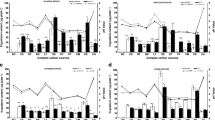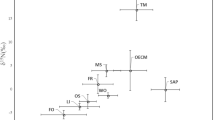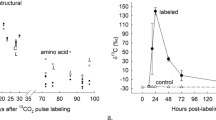Abstract
The utilisation of a range of cell-wall-related and aromatic carbon substrates by multiple genotypes of three ericoid mycorrhizal fungal taxa was compared with two orchid mycorrhizal fungal taxa. Both groups of fungi catabolised most common substrates, though significant inter- and intraspecific variability was observed in the use of a few carbon substrates. Orchid mycorrhizal fungi had limited access to tannic acid as a carbon source and did not use phenylalanine, while the ericoid mycorrhizal fungi used both. Utilisation of tryptophan was limited to single genotypes of each of the orchid mycorrhizal fungi, and to only two of the three ericoid mycorrhizal fungi examined. Although broadly similar, some significant differences apparently exist in carbon catabolism of ericoid and orchid mycorrhizal fungi from the same habitat. Functional and ecological implications of these observations are discussed.


Similar content being viewed by others
References
Anderson IC, Chambers SM, Cairney JWG (1999) Intra- and interspecific varation in patterns of organic and inorganic nitrogen utilization by three Australian Pisolithus species. Mycol Res 103:1579–1587
Barroso J, Chaves Neves H, Pais MSS (1985) Ultrastructural, cytochemical and biochemical aspects related to the formation of O. lutea endomycorrhizae. In: Gianinazzi-Pearson V, Gianinazzi S (eds) Physiological and genetical aspects of mycorrhizae. Proceedings of the 1st European symposium on mycorrhizae, Dijon, 1985
Bending GD, Read DJ (1996a) Effects of the soluble polyphenol tannic acid on the activities of ericoid and ectomycorrhizal fungi. Soil Biol Biochem 28:1595–1602
Bending GD, Read DJ (1996b) Nitrogen mobilization from protein–polyphenol complexes by ericoid and ectomycorrhizal fungi. Soil Biol Biochem 28:1603–1612
Bougoure JJ, Bougoure DS, Cairney JWG, Dearnaley JDW (2005) ITS-RFLP and sequence analysis of endophytes from Acianthus, Caladenia and Pterostylis (Orchidaceae) in southeastern Queensland. Mycol Res 109:452–460
Burgeff H (1909) Die wurzelpilze der orchideen, ihre kultur und ihre leben in der pflanze. Gustav Fischer, Jena
Burgeff H (1936) Samenkeimung der orchideen. Gustav Fischer, Jena
Burke RM, Cairney JWG (1997a) Carohydrolase production by the ericoid mycorrhizal fungus Hymenoscyphus ericae under solid state fermentation conditions. Mycol Res 101:1135–1139
Burke RM, Cairney JWG (1997b) Purification and characterisation of a β-1-4-endoxylanase from the ericoid mycorrhizal fungus Hymenoscyphus ericae. New Phytol 135:345–352
Cairney JWG, Burke RM (1998) Extracellular enzyme activities of the ericoid mycorrhizal endophyte Hymenoscyphus ericae (Read) Korf & Kernan: their likely roles in decomposition of dead plant material in soil. Plant Soil 205:181–192
Cairney JWG (1999) Intraspecific physiological variation: implications for understanding functional diversity in ecotmycorrhizal fungi. Mycorrhiza 9:125–135
Cairney JWG, Meharg AA (2003) Ericoid mycorrhiza: a partnership that exploits harsh edaphic conditions. Eur J Soil Sci 54:735–740
Cairney JWG, Sawyer NA, Sharples JM, Meharg AA (2000) Intraspecific variation in nitrogen source utilisation by isolates of the ericoid mycorrhizal endophyte Hymenoscyphus ericae (Read) Korf and Kernan. Soil Biol Biochem 32:1319–1322
Guidot A, Verner M-C, Debaud JC, Marmeisse R (2005) Intraspecific varation in use of different organic nitrogen sources by the ectomycorrhizal fungus Hebeloma cylindrosporum. Mycorrhiza 15:167–177. DOI 10.1007/s00572-004-0318-1
Hadley G, Perombelon M (1963) Production of pectic enzymes by Rhizoctonia solani and orchid endophytes. Nature 200:1337
Herrick, JA (1940) The growth of Stereum gausapatum Fries in relation to temperature and acidity. Ohio J Sci 40:123–129
Holländer S (1932) Ernährungsphysiologische untersuchungen an wurzelpilzen saprophytisch lebender orchideen. Julius-Maximilian-Universität, Würtzberg
Jennings DH (1995) The physiology of fungal nutrition. Cambridge University Press, Cambridge
Johnson GT, Jones AC (1941) Data on the cultural characteristics of a species of Coprinus. Mycologia 33:133–140
Kerley SJ, Read DJ (1995) The biology of mycorrhiza in the Ericaceae. XVIII. Chitin degradation by Hymenoscyphus ericae and transfer of chitin–nitrogen to the host plant. New Phytol 131:369–375
King SA, Buckney RT (2002) Invasion of exotic plants in nutrient-enriched urban bushland. Austral Ecol 27:573–583 DOI 10.1046/J.1442-9993.2002.01220.X
Leake JR, Read DJ (1990) Proteinase activity in mycorrhizal fungi. I. The effect of extracellular pH on the production and activity of proteinase by ericoid endophytes from soils of contrasted pH. New Phytol 115:243–250
Leake JR, Read DJ (1997) Mycorrhizal fungi in terrestrial habitats. In: Wicklow D and Söderström B (eds) The mycota. IV. Environmental and microbial relationships. Springer, Berlin Heidelberg New York, pp 281–301
Marx DH, Bryan WC (1975) Growth and ectomycorrhizal development of lobolly pine seedlings in fumigated soil infested with the fungal symbiont Pisolithus tintorius. For Sci 21:245–254
Meletiadis J, Meis JFGM, Mouton JW, Verweij PE (2001) Analysis of growth characteristics of filamentous fungi in different nutrient media. J Clin Microbiol 39:478–484
Midgley DJ, Chambers SM, Cairney JWG (2002) Spatial distribution of fungal endophyte genotypes in a Woollsia pungens (Ericaceae) root system. Aust J Bot 50:559–565
Midgley DJ, Chambers SM, Cairney JWG (2004a) Utilisation of carbon substrates by multiple genotypes of ericoid mycorrhizal fungal endophytes from eastern Australian Ericaceae. Mycorrhiza 14:245–251
Midgley DJ, Chambers SM, Cairney JWG (2004b) Inorganic and organic substrates as sources of nitrogen and phosphorus for multiple genotypes of two ericoid mycorrhizal fungal taxa from Woollsia pungens and Leucopogon parviflorus (Ericaceae). Aust J Bot 52:63–71
Midgley DJ, Chambers SM, Cairney JWG (2004c) Distribution of ericoid mycorrhizal endophytes and root-associated fungi in neighbouring Ericaceae plants in the field. Plant Soil 259:137–151
Nieuwdorp PJ (1972) Some observations with light and electron microscope on the endotrophic mycorrhiza of orchids. Acta Bot Neerl 21:128–144
Perkins AJ, McGee PA (1995) Distribution of the orchid mycorrhizal fungus Rhizoctonia solani in relation to its host Pterostylis acuminata in the field. Aust J Bot 43:565–575
Perotto R, Bettini V and Bonfante P (1993) Evidence of two polygalacturonases produced by a mycorrhizal ericoid fungus during saprotrophic growth. FEMS Microbiol Lett 114:85–92
Perotto S, Coisson J D, Perugini O, Cometi V, Bonfante P (1997) Production of pectin-degrading enzymes by ericoid mycorrhizal fungi. New Phytol 135:151–162
Piercey MM, Thormann MN, Currah RS (2002) Saprotrophic characteristics of three fungal taxa from ericalean roots and their association with the roots of Rhododendron groenlandicum and Picea mariana in culture. Mycorrhiza 12:175–180
Pope EJ (2001) A hierarchical analysis of functional and genetic diversity within the Rhizoctonia solani species complex. Ph.D. thesis. Deparment of Microbiology, Faculty of Science, University of Sydney
Rasmussen HN (1995) Terrestrial orchids, from seed to mycotrophic plant. Cambridge University Press, Cambridge
Read DJ (1991) Mycorrhizas in ecosystems. Experientia 47:376–390
Richard P, Londesborough J, Putkonen, M, Kalkkinen N, Penttila, M (2001) Cloning and expression of a fungal l-arabinitol 4 dehydrogenase gene. J Biol Chem 276:40631–40632
Sawyer NA, Chambers SM, Cairney JWG (2003) Utilisation of inorganic and organic nitrogen sources by Amanita species native to temperate eastern Australia. Mycol Res 104:413–420
Smith SE (1966) Physiology and ecology of orchid mycorrhizal fungi with reference to seedling germination. New Phytol 65:488–499
Smith SE, Read DJ (1997) Mycorrhizal symbiosis, 2nd ed. Academic, London
Taylor DL, Bruns, TD (1999) Population, habitat and genetic correlates of mycorrhizal specialization in the ‘cheating’ orchids Corallorhiza maculata and C. mertensiana. Mol Ecol 8:1719–1732
Varma A, Bonfante P (1994) Utilisation of cell-wall related carbohydrates by ericoid mycorrhizal endophytes. Symbiosis 16:301–313
Warcup JH (1971) Specificity of mycorrhizal association in some Australian terrestrial orchids. New Phytol 70:41–46
Warcup JH (1981) The mycorrhizal relationships of Australian orchids. New Phytol 87:371–381
Whittaker SP, Cairney JWG (2001) Influence of amino acids on biomass production by ericoid mycorrhizal endophytes from Woollsia pungens (Epacridaceae). Mycol Res 105:105–111
Wolff H (1933) Zur assimilation atmosphärischen stickstoffs durch die wurzelpilze von Coralliorhiza innata R. Br., sowie der epiphyten Cattleya bowringiana und Laelia anceps Ldl. Jahrb Wiss Bot 77:657–684
Zelmer LW, Cuthbertson L, Currah RS (1996) Fungi associated with terrestrial orchid mycorrhizas, seeds and protocorms. Mycoscience 37:439–448
Acknowledgements
We gratefully acknowledge Mr. Endymion Cooper for his assistance in a pilot project with the OM fungi used in this study, and Dr. Andrew Perkins for allowing us access to his collection of orchid mycorrhizal fungi at the University of Sydney.
Author information
Authors and Affiliations
Corresponding author
Rights and permissions
About this article
Cite this article
Midgley, D.J., Jordan, L.A., Saleeba, J.A. et al. Utilisation of carbon substrates by orchid and ericoid mycorrhizal fungi from Australian dry sclerophyll forests. Mycorrhiza 16, 175–182 (2006). https://doi.org/10.1007/s00572-005-0029-2
Received:
Accepted:
Published:
Issue Date:
DOI: https://doi.org/10.1007/s00572-005-0029-2




